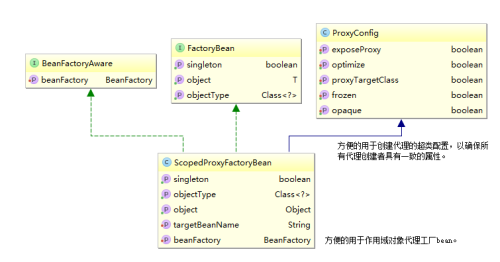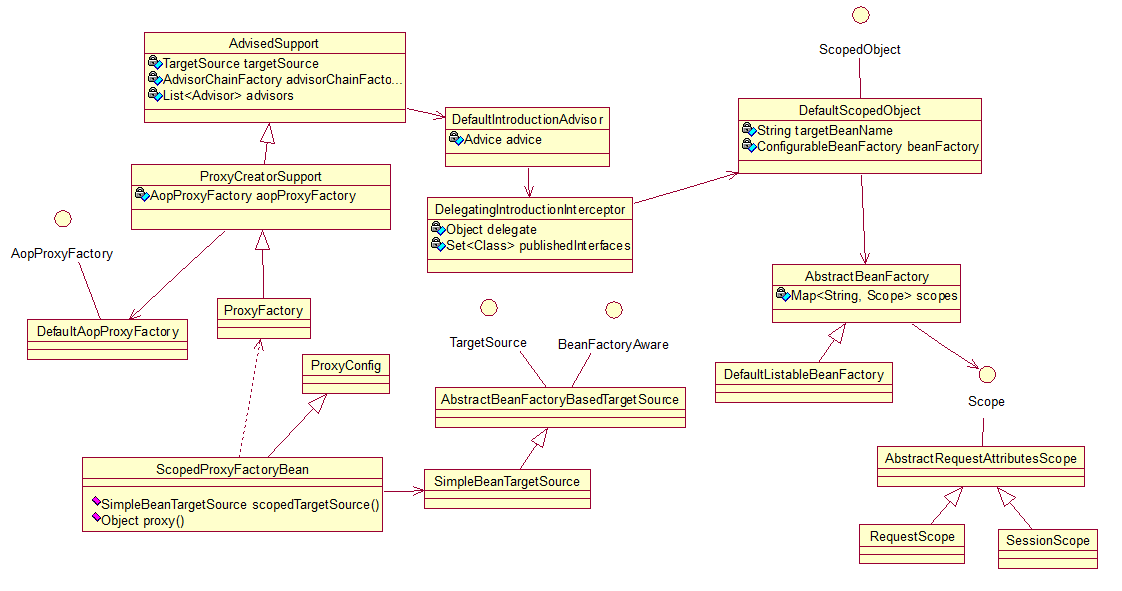J2EE開發者,對購物車這個概念太熟悉了。存在於Session週期中。今天就說說,如果用Spring管理購物車,怎麼處理。
使用場景
<bean id="cart" class="com.hellojd.jpetstore.domain.model.Cart" scope="session"> <aop:scoped-proxy proxy-target-class="true"/> </bean>
必須要聲明 <aop:scoped-proxy..>
或者 annotation配置
@Scope(value="session",proxyMode= ScopedProxyMode.TARGET_CLASS)
@Component
public class Cart implements Serializable {
...
}經過上面的配置,就可以在controller中,注入使用了。
接下來,分析spring是如何管理購物車的.
2. 源碼分析
2.1 ScopedProxyFactoryBean 類圖
既然ScopedProxyFactoryBean,是個FactoryBean,就關注下getObject()
public Object getObject() {
if (this.proxy == null) {
throw new FactoryBeanNotInitializedException();
}
return this.proxy;
}重點是proxy屬性的維護了。在BeanFactoryAware.setBeanFactory接口方法中初始化。
發生時機:普通屬性注入之後,InitializingBean.afterPropertiesSet() 和 custom init-method之前
public void setBeanFactory(BeanFactory beanFactory) {
if (!(beanFactory instanceof ConfigurableBeanFactory)) {
throw new IllegalStateException("Not running in a ConfigurableBeanFactory: " + beanFactory);
}
ConfigurableBeanFactory cbf = (ConfigurableBeanFactory) beanFactory;
this.scopedTargetSource.setBeanFactory(beanFactory);
ProxyFactory pf = new ProxyFactory();
pf.copyFrom(this);
pf.setTargetSource(this.scopedTargetSource);
Class beanType = beanFactory.getType(this.targetBeanName);
if (beanType == null) {
throw new IllegalStateException("Cannot create scoped proxy for bean '" + this.targetBeanName +
"': Target type could not be determined at the time of proxy creation.");
}
if (!isProxyTargetClass() || beanType.isInterface() || Modifier.isPrivate(beanType.getModifiers())) {
//設置源接口
pf.setInterfaces(ClassUtils.getAllInterfacesForClass(beanType, cbf.getBeanClassLoader()));
}
// 爲增加DefaultScopedObject能力,增加introduction
ScopedObject scopedObject = new DefaultScopedObject(cbf, this.scopedTargetSource.getTargetBeanName());
pf.addAdvice(new DelegatingIntroductionInterceptor(scopedObject));
// Add the AopInfrastructureBean marker to indicate that the scoped proxy
// itself is not subject to auto-proxying! Only its target bean is.
pf.addInterface(AopInfrastructureBean.class);
this.proxy = pf.getProxy(cbf.getBeanClassLoader());
}| TargetSource | 用於獲取AOP調用的當前“目標” | Target |
| AbstractBeanFactoryBasedTargetSource | 基於Spring BeanFactory的實現TargetSource的基類 | Target |
| ProxyConfig | 方便的用於創建代理的超類配置 | AOP |
| ProxyFactory | 編程式AOP代理工廠 | AOP |
| ProxyCreatorSupport | 代理工廠的基類 | AOP |
| AdvisedSupport | 代理配置元信息管理基類AOP | AOP |
| AopProxyFactory | 創建AOP代理的工廠 | |
| ScopedObject | 用於範圍對象的AOP接口 | |
DefaultScopedObject | 完成從spring中獲取 | |
| DelegatingIntroductionInterceptor | 委託引入攔截器 | |
3.RequestScope VS SessionScope
public class SessionScope extends AbstractRequestAttributesScope {
public String getConversationId() {
return RequestContextHolder.currentRequestAttributes().getSessionId();
}
@Override
public Object get(String name, ObjectFactory objectFactory) {
Object mutex = RequestContextHolder.currentRequestAttributes().getSessionMutex();
synchronized (mutex) {
return super.get(name, objectFactory);
}
}
@Override
public Object remove(String name) {
Object mutex = RequestContextHolder.currentRequestAttributes().getSessionMutex();
synchronized (mutex) {
return super.remove(name);
}
}
...
} or
public abstract class AbstractRequestAttributesScope implements Scope {
public Object get(String name, ObjectFactory objectFactory) {
RequestAttributes attributes = RequestContextHolder.currentRequestAttributes();
Object scopedObject = attributes.getAttribute(name, getScope());
if (scopedObject == null) {
scopedObject = objectFactory.getObject();
attributes.setAttribute(name, scopedObject, getScope());
}
return scopedObject;
}
public Object remove(String name) {
RequestAttributes attributes = RequestContextHolder.currentRequestAttributes();
Object scopedObject = attributes.getAttribute(name, getScope());
if (scopedObject != null) {
attributes.removeAttribute(name, getScope());
return scopedObject;
}
else {
return null;
}
}
...
}

